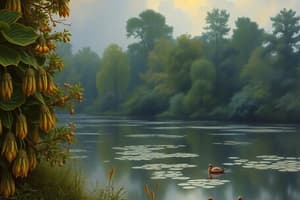Podcast
Questions and Answers
Which of the following best describes a producer in an ecosystem?
Which of the following best describes a producer in an ecosystem?
- Organisms that compete for food
- Organisms that break down dead material
- Plants and other photosynthetic/chemosynthetic organisms (correct)
- Animals that eat other animals
In an ecosystem, there are more predators than prey at any given time.
In an ecosystem, there are more predators than prey at any given time.
False (B)
What are biotic factors?
What are biotic factors?
Living components in an ecosystem that affect its structure and dynamics.
A _____ is defined as a community of interacting organisms and their physical environment.
A _____ is defined as a community of interacting organisms and their physical environment.
Match the following abiotic factors with their descriptions:
Match the following abiotic factors with their descriptions:
Which factor is NOT considered an abiotic component?
Which factor is NOT considered an abiotic component?
Symbiotic relationships can negatively impact at least one of the organisms involved.
Symbiotic relationships can negatively impact at least one of the organisms involved.
What is bioaccumulation?
What is bioaccumulation?
What is the term for competition between members of the same species?
What is the term for competition between members of the same species?
Allelopathy in plants involves the release of biochemicals to promote the growth of other plants.
Allelopathy in plants involves the release of biochemicals to promote the growth of other plants.
Define parasitism in the context of symbiosis.
Define parasitism in the context of symbiosis.
The ecological niche refers to the specific ______ an organism occupies in an ecosystem.
The ecological niche refers to the specific ______ an organism occupies in an ecosystem.
Match the type of symbiosis with its description.
Match the type of symbiosis with its description.
Which of the following is an example of a mutualistic relationship?
Which of the following is an example of a mutualistic relationship?
No two species can occupy the same ecological niche according to the competitive exclusion principle.
No two species can occupy the same ecological niche according to the competitive exclusion principle.
What is the main cause of the spread of Devil Facial Tumour Disease in Tasmanian devils?
What is the main cause of the spread of Devil Facial Tumour Disease in Tasmanian devils?
Capture-recapture techniques help estimate the population of highly ______ organisms.
Capture-recapture techniques help estimate the population of highly ______ organisms.
What technique is used to measure the distribution of immobile animals or plants?
What technique is used to measure the distribution of immobile animals or plants?
Generalist species are likely to die out due to strong competition and lack of resources.
Generalist species are likely to die out due to strong competition and lack of resources.
What is the equation used to estimate a total population in capture-recapture techniques?
What is the equation used to estimate a total population in capture-recapture techniques?
The ______ of the Australian Megafauna included species like giant wombats.
The ______ of the Australian Megafauna included species like giant wombats.
Match the following species to their ecological roles or features.
Match the following species to their ecological roles or features.
What should be done with vegetation, seeds, and seedlings before rehabilitation?
What should be done with vegetation, seeds, and seedlings before rehabilitation?
The only way to treat tailings is by storing them on-site with no further action.
The only way to treat tailings is by storing them on-site with no further action.
What must be done to the pit after mining is completed?
What must be done to the pit after mining is completed?
Minimising ploughing helps to prevent soil erosion by reducing the exposure of _____ soil.
Minimising ploughing helps to prevent soil erosion by reducing the exposure of _____ soil.
Match the methods of reducing erosion with their descriptions:
Match the methods of reducing erosion with their descriptions:
What are the two primary theories explaining the extinction of Australian megafauna?
What are the two primary theories explaining the extinction of Australian megafauna?
All large animals in Australia went extinct due to human arrival.
All large animals in Australia went extinct due to human arrival.
What role did Aboriginal rock paintings play in understanding past ecosystems?
What role did Aboriginal rock paintings play in understanding past ecosystems?
The Thylacine is also known as the __________.
The Thylacine is also known as the __________.
Match the evidence type with its description:
Match the evidence type with its description:
Which event is believed to have contributed to the extinction of megafauna before the last ice age?
Which event is believed to have contributed to the extinction of megafauna before the last ice age?
Dingoes, introduced by Aboriginal people, were ineffective predators.
Dingoes, introduced by Aboriginal people, were ineffective predators.
Explain what iron banded formations signify in geological studies.
Explain what iron banded formations signify in geological studies.
Palaeontological and geological evidence helps to understand the history of the __________ and predictions for future events.
Palaeontological and geological evidence helps to understand the history of the __________ and predictions for future events.
Match the following extinct species with their descriptions:
Match the following extinct species with their descriptions:
What geological evidence indicates past changes in Earth’s atmosphere?
What geological evidence indicates past changes in Earth’s atmosphere?
The extinction of megafauna in Australia was solely caused by natural climate changes.
The extinction of megafauna in Australia was solely caused by natural climate changes.
What is the significance of gas analysis in studying past climates?
What is the significance of gas analysis in studying past climates?
The __________ method measures the radioactive decay of isotopes to determine the age of materials.
The __________ method measures the radioactive decay of isotopes to determine the age of materials.
Which of the following factors contributed to the extinction of the Thylacine?
Which of the following factors contributed to the extinction of the Thylacine?
What is a major consequence of human-induced land clearing?
What is a major consequence of human-induced land clearing?
Eutrophication occurs when fertilizers wash into rivers, leading to a decline in aquatic biodiversity.
Eutrophication occurs when fertilizers wash into rivers, leading to a decline in aquatic biodiversity.
What is salinisation?
What is salinisation?
The process by which accumulated toxic pesticides move up food chains and increase in concentration is called ___.
The process by which accumulated toxic pesticides move up food chains and increase in concentration is called ___.
Match the following factors to their effects on ecosystems:
Match the following factors to their effects on ecosystems:
Which of the following is a primary cause of salinisation?
Which of the following is a primary cause of salinisation?
Human overpopulation has no significant impact on ecosystems.
Human overpopulation has no significant impact on ecosystems.
Name one method that can be used to mitigate the impacts of mining on ecosystems.
Name one method that can be used to mitigate the impacts of mining on ecosystems.
The accumulation of nitrogen and phosphorus from fertilizers can lead to a rapid growth of algae, known as ___.
The accumulation of nitrogen and phosphorus from fertilizers can lead to a rapid growth of algae, known as ___.
What is one effect of climate change on ecosystems?
What is one effect of climate change on ecosystems?
Biologists study past extinction events to create models predicting future biodiversity impacts.
Biologists study past extinction events to create models predicting future biodiversity impacts.
What is an example of an introduced species in Australia?
What is an example of an introduced species in Australia?
Human activities that exploit natural resources rapidly can lead to the ___ of ecosystems.
Human activities that exploit natural resources rapidly can lead to the ___ of ecosystems.
Which factor contributes to the rising sea levels?
Which factor contributes to the rising sea levels?
Match the following processes to their descriptions:
Match the following processes to their descriptions:
Study Notes
Food Chains and Ecosystems
- Bioaccumulation refers to the accumulation of toxic substances in organisms through the food chain, particularly affecting top predators.
- The biosphere encompasses all living organisms and their interactions with both biotic (living) and abiotic (non-living) components.
Ecosystem Components
- Ecosystems consist of communities of interacting organisms and their physical environments, which vary by type, such as terrestrial and aquatic.
- Abiotic factors include light, temperature, rainfall, and soil quality, significantly influencing habitat suitability for organisms.
- Biotic factors involve interactions among living organisms (predation, competition, symbiosis) that impact population dynamics and ecosystems.
Trophic Levels
- Producers (photosynthetic organisms), consumers (animals), and decomposers (fungi and microbes) form the foundational components of food webs.
- Predator-prey relationships are dynamic, with predator populations fluctuating in sync with prey populations.
Competition
- Competitive interactions can be intraspecific (within the same species) or interspecific (between different species).
- Allelopathy in plants illustrates competition for resources, influencing neighboring plant growth negatively or positively.
Symbiosis
- Symbiotic relationships can be mutualistic (both benefit), commensalistic (one benefits, the other unaffected), or parasitic (one benefits at the expense of another).
- Coral reefs exemplify mutualism, where coral and algae support diverse marine life.
Disease Dynamics
- Diseases are detrimental to organisms, with infectious diseases being a major threat within ecosystems, particularly when infection spreads due to environmental changes.
Ecological Niches
- Ecological niches define the role and space occupied by species within an ecosystem and influence interactions and biodiversity.
- Competitive exclusion principle suggests that no two species can occupy identical niches without one eventually dominating.
Population Measurement Techniques
- Various sampling techniques help estimate species distribution and abundance, especially when direct counts are impractical.
- Quadrats and transects are used for plants and immobile animals, while capture-recapture methods estimate populations of mobile species.
Extinction Events
- Australian Megafauna, including species like Diprotodon and Megalania, went extinct around 40,000 years ago due to climate changes and human arrival.
- The Tasmanian tiger (Thylacine) faced extinction due to human actions, habitat loss, and competition with introduced species.
Evidence of Past Ecosystems
- Palaeontology and geology provide insights into historical ecosystems through fossil evidence, rock formations, and Aboriginal rock paintings depicting past biodiversity.
- Ice core drilling captures atmospheric composition changes, informing about climate shifts over geological time.
Human Impact on Ecosystems
- Human overpopulation and resource exploitation have introduced selection pressures on ecosystems, such as salinisation, pesticide use, and eutrophication.
- Introduced species often disrupt ecological balances, leading to the decline of native species.
Future Ecosystems and Biodiversity
- Predictive models based on past extinction events help assess future biodiversity impacts stemming from human activity and climate change.
- Mining affects ecosystems, emphasizing the importance of rehabilitation to recover the environment post-extraction.
Climate Change Effects
- Climate change results in rising global temperatures, extreme weather, and disruptions in freshwater availability, threatening ecosystem stability.
- Responsible management of biodiversity is crucial as changing climates continue to shape ecological dynamics.### Mining Rehabilitation
- Clearing, stockpiling, and caring for vegetation, seeds, and seedlings is essential for later rehabilitation of mining sites.
- Tailings, or waste materials from mining, require proper treatment and management.
- After mining concludes, pits can be refilled with either landfill or water, resulting in the formation of a dam.
- Stockpiled soil is respread over the mining area, followed by a staged introduction of vegetation.
- Successful rehabilitation allows for the return of native animals and plants to the ecosystem.
Agricultural Land Degradation
- Soil serves as the foundation for terrestrial agriculture, crucial for feeding the global population.
- Traditional ploughing practices increase soil erosion by exposing surface soil to rain and wind, leading to loss of fine particles and nutrients.
Erosion Mitigation Strategies
- Minimizing ploughing can reduce soil disturbance; environmentally friendly chemicals can effectively control weeds.
- Re-planting vegetation, such as trees, helps anchor soil with roots and mitigates erosion risks.
- Construction sites in Australia are legally required to implement temporary silt traps to capture sediment and prevent contamination of local waterways.
- Maintaining vegetation cover on road verges, new developments, and drainage banks helps prevent erosion and supports wildlife habitats.
- Utilizing native vegetation not only aids erosion control but also creates wildlife corridors and contributes to environmental rehabilitation.
Studying That Suits You
Use AI to generate personalized quizzes and flashcards to suit your learning preferences.
Description
Explore the intricate relationships within ecosystems, focusing on the food chain dynamics and the concept of bioaccumulation in top predators. This quiz delves into the biosphere, the interaction between biotic and abiotic factors, and how these elements shape populations within various ecosystems.





